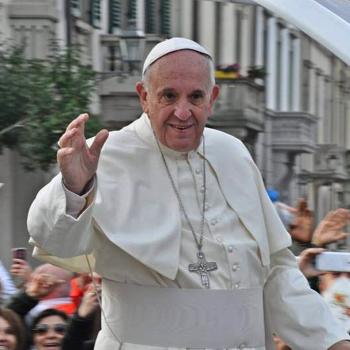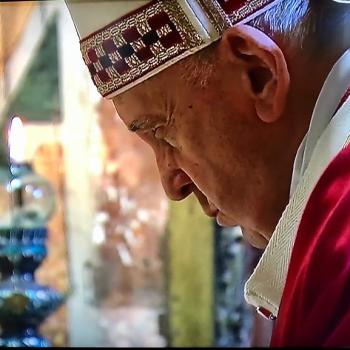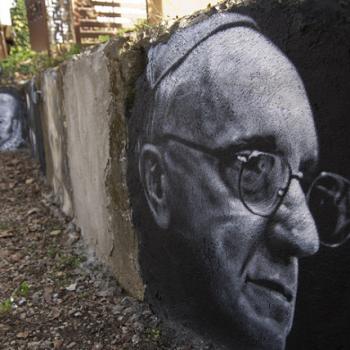I first read about the Shroud of Turin when I picked up a book about it in the library. I was deep in my anti-religion period at that time, struggling to find arguments against the existence of God.
I read most of the atheist literature, both of that time and of earlier decades. I wanted to be convinced. But the things I read just weren’t all that convincing. Since I’m neither a scholar nor an intellectual, I usually employ a vacuum cleaner approach to learning about a subject that interests me.
I read everything I can get my hands on, then track down the original sources that the first books referenced and read them. It’s a process that can go on for a while. I plumbed through atheist thinking all the way to its bottom in my search to prove there was no god and found nothing but the authors themselves.
I’m not a scholar or an intellectual, but I’m also not flat-footed stupid. The arguments by the old atheists are like the arguments of the new atheists. They don’t hold up if you think about them. Most of them are self-refuting. In fact, based on the books by the so-called “new atheists” that I’ve read, I don’t see their thinking as thinking. It’s just a rehash of what has been said before, topped off with insult and rudeness.
I did not want to believe in god back in those days. I was so cynical about god and so disappointed in him and his people that I would have preferred it if I had been able to not believe in him in some absolute and rock solid way. I wanted to cast god and what I saw as his failure out with the orange peels and old paycheck stubs in my trashcan. He seemed as spent and meaningless to me as they were.
However, reading atheist thought was not a convincing exercise. If my understanding of god made me cynical about him, my exposure to the thoughts of those who denied him actually made his existence sound almost unavoidably possible.
One thing that sharpened my understanding was my propensity to go back and forth. I would read the arguments against, then read the documents these arguments were critiquing.
I invariably found that those arguments against that I had read were based on partial quotes taken out of context and given meaning they did not mean, or facts that were likewise taken out of context and given meaning they did not mean. Atheist arguments fell apart when I traced them back to their original sources.
I had never heard of the Shroud of Turin when I plucked that book off the library shelves. i didn’t expect to be impressed by the book. But, well, my vacuum cleaner mind sweeps up everything, including the trivial. I took it home, and since it was a short book, read it before bed that night.
The book was written by one of the members of a group of scientists who had examined the Shroud in the 1970s’ STURP investigation. It didn’t claim the Shroud was the burial cloth of Christ. It simply described the experiments. The thing about the book that impressed me the most is that I didn’t see any hint that its author was lying. I didn’t know what to make of the Shroud itself. But I felt that if the author of this book was telling the truth — and I thought he was — then the Shroud was a lot more than a fake miracle made with pigeon’s blood and a shadow box.
I returned the book to the library and thought no more about Shroud until I heard that carbon dating experiments indicated that it was a fake from the Middle Ages. I had experienced my conversion to Christ between when I read the book and when these results were announced. But that wasn’t why the carbon dating results perplexed me. I believed almost immediately that the results were inaccurate.
I felt this way because I still believed that the author of that original book I had read was telling the truth about his experiments on the Shroud. I just didn’t see how the artifact described in that book could be a Medieval forgery. Forgeries of that era were crude compared to the Shroud on so many levels. In fact, the Shroud would have been a poor forgery by the standards of that day, with its faint negative image. From what I’d read, you can’t even really see the thing until you see it as a negative from a camera. And the anatomical details, including those of the damage done to the man in the Shroud’s body went way beyond what a Medieval forger would need or even have the knowledge to fake.
Add to that the simple fact that no one could figure out how to re-create the Shroud using the tools of any century, much less tools from the technologically weak past of 800 years ago, and I simply did not believe that the carbon dating results were accurate. I didn’t think they were forged or deliberately falsified. I didn’t think the protocols used in doing the dating had been bad. But I still didn’t think things added up.
All this led me, for the first time, to stop and think, Is this cloth really the winding sheet of Christ? Is the face on that cloth the face of the Lord Jesus as He lay in the tomb?
The thing that brought me to this question was that I thought I could see the logic behind obscuring the truth about a genuine Shroud from a Divine viewpoint. I think proof of this simple type would obviate faith for a lot of people. It could also lead many of us to fall into superstitions about the Shroud instead of a dynamic faith in Christ.
These thoughts went through my mind and then I stopped speculating and went on with my life. I didn’t need the Shroud to prove anything to me. The conversion experince I’d had was enough proof for my lifetime.
When I first read that Pope Benedict XVI had granted a televised viewing of the Shroud on Holy Saturday March 30, I thought it was nice. Then, the Pope resigned and everything he had done or said seemed outlined in high-lighter for me. I read a lot about him, and during the reading I learned that Pope Benedict had come just about as close as he could to saying that he believed the Shroud was genuine without actually using those precise words. I also kept seeing comments about “new evidence.”
Ok, I thought. New evidence. What is it? I’m still trying to get sufficient information to answer that question. I need more information than a scientist would, simply because it takes more information for me to understand what I’m reading,.
All I know for sure is that Pope Benedict seemed to be leaning heavily toward a belief that the Shroud is genuine and that Pope Francis, while more circumspect, did not gainsay him.
I don’t think it matters whether you believe that the Shroud is the burial cloth or not. The only danger would be if you fell off the horse and started regarding it as an idol and a superstition. Faith in Jesus does not need the Shroud; not if you’ve encountered Him personally.
On the other hand, it is tantalizing. I look at the photos of the man in the Shroud, at his torn body and the obvious torture he suffered, and then I contrast that with the serene expression on his face. I can look at that face for quite a while and, despite it’s swollen eye and battered condition, I never see anything but peace.
Who are you? I wonder.
So far at least, there is no answer.












